外研版英语八年级下Revision module A教案(1课时)
文档属性
| 名称 | 外研版英语八年级下Revision module A教案(1课时) | 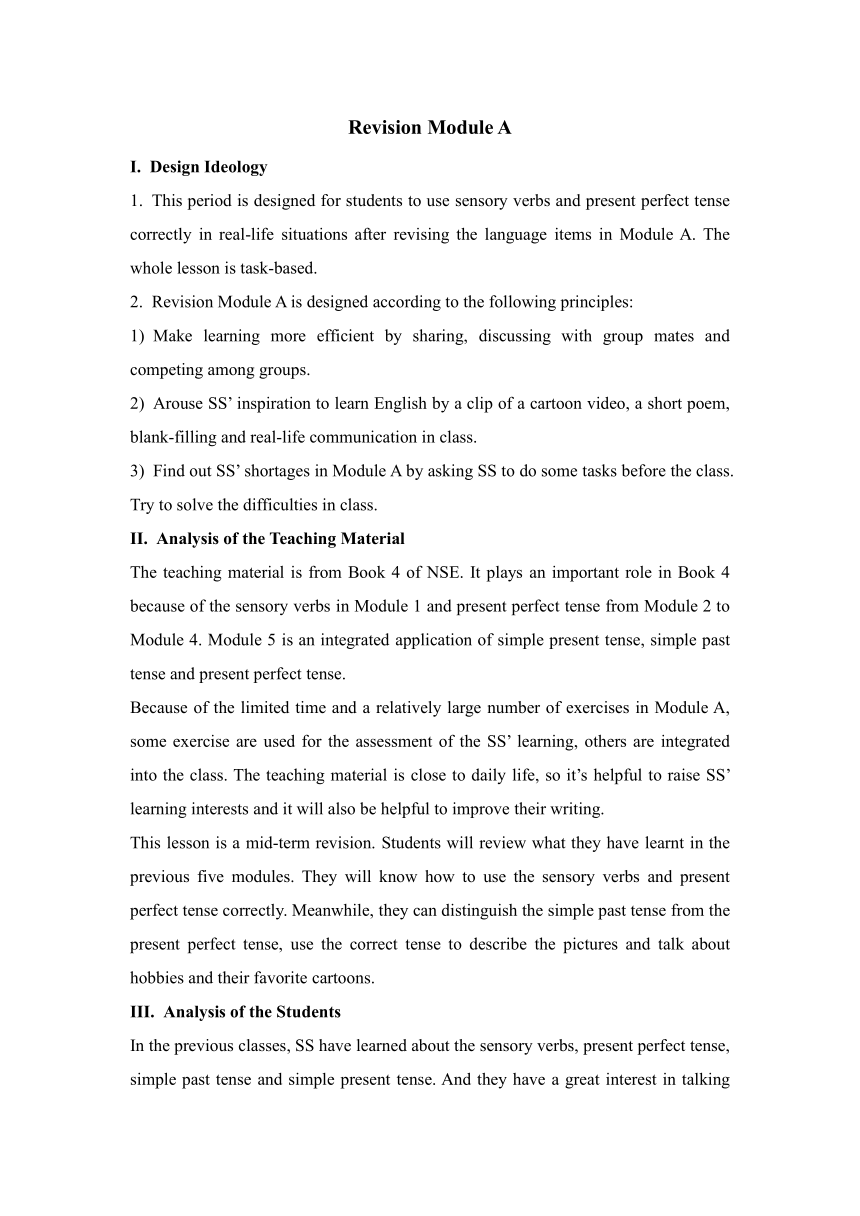 | |
| 格式 | doc | ||
| 文件大小 | 89.5KB | ||
| 资源类型 | 教案 | ||
| 版本资源 | 外研版 | ||
| 科目 | 英语 | ||
| 更新时间 | 2022-06-01 11:11:34 | ||
图片预览

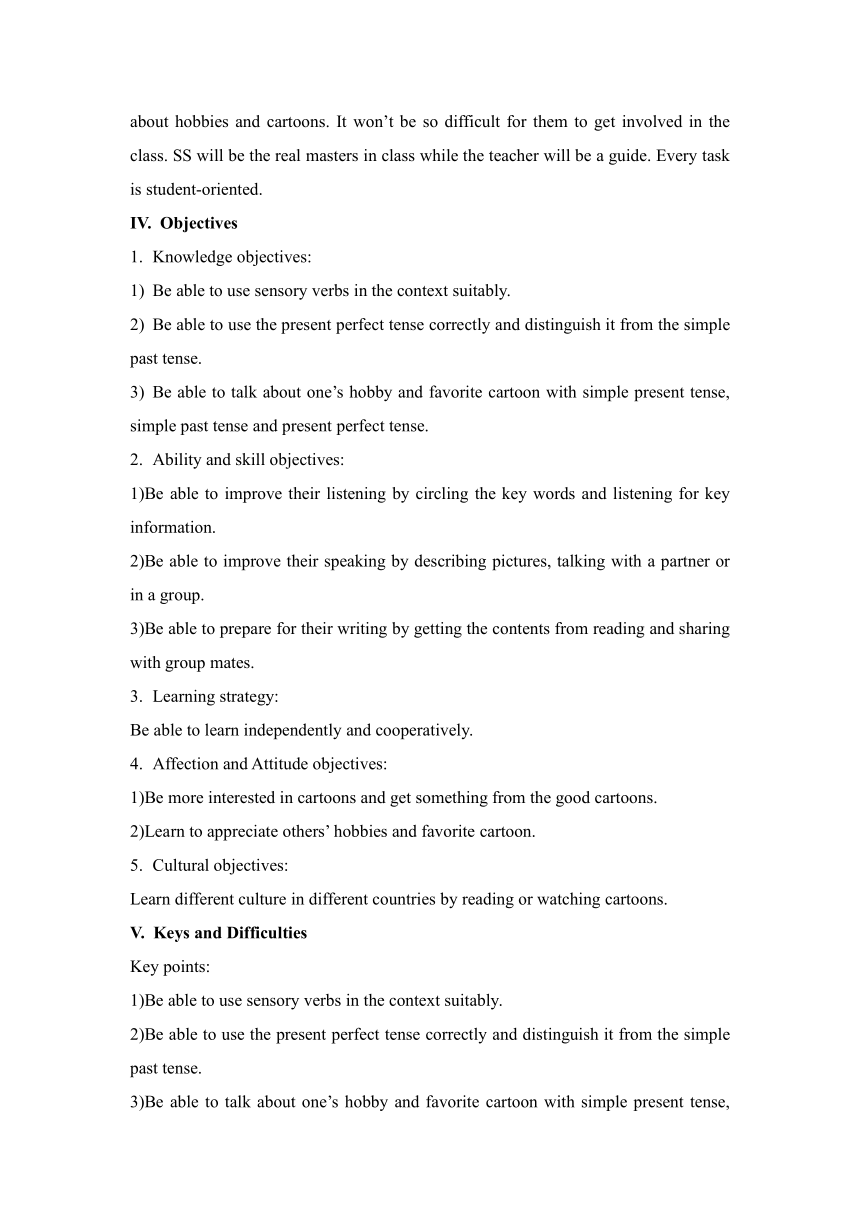
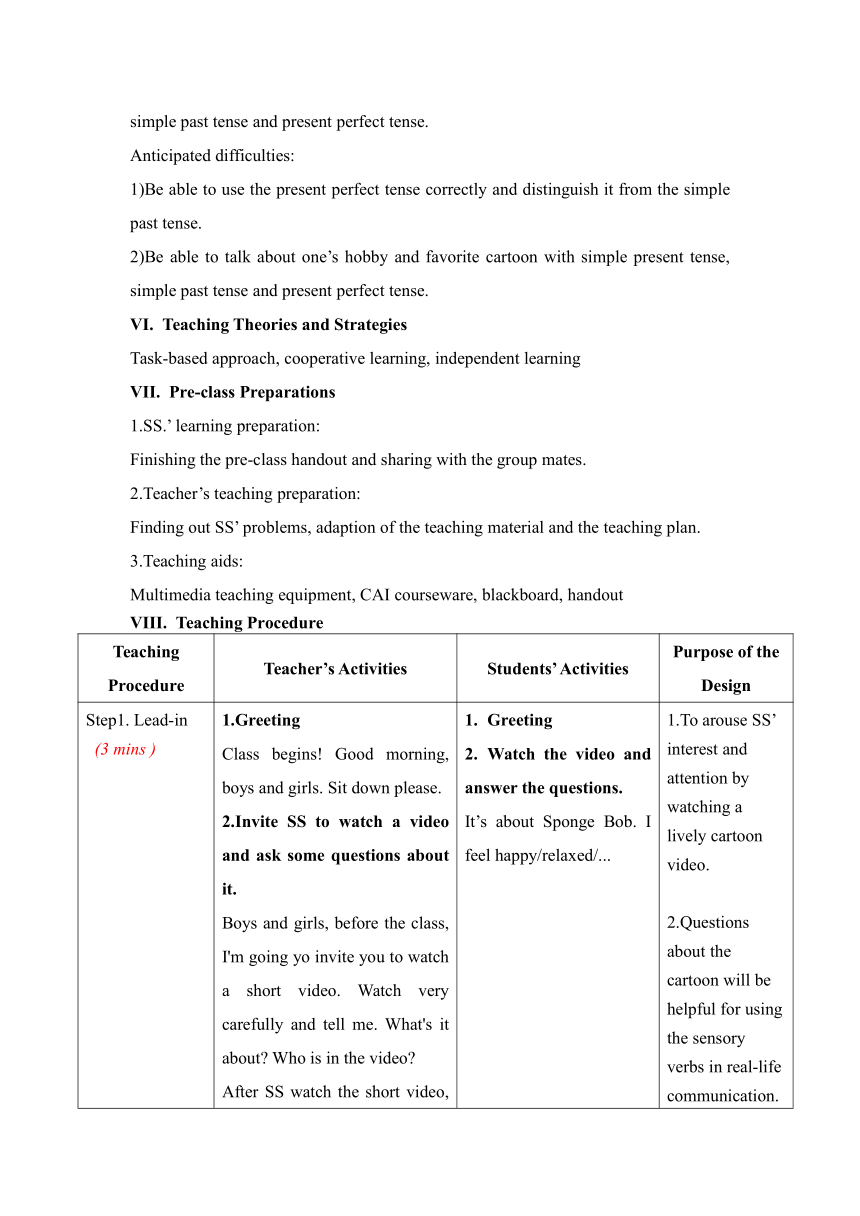
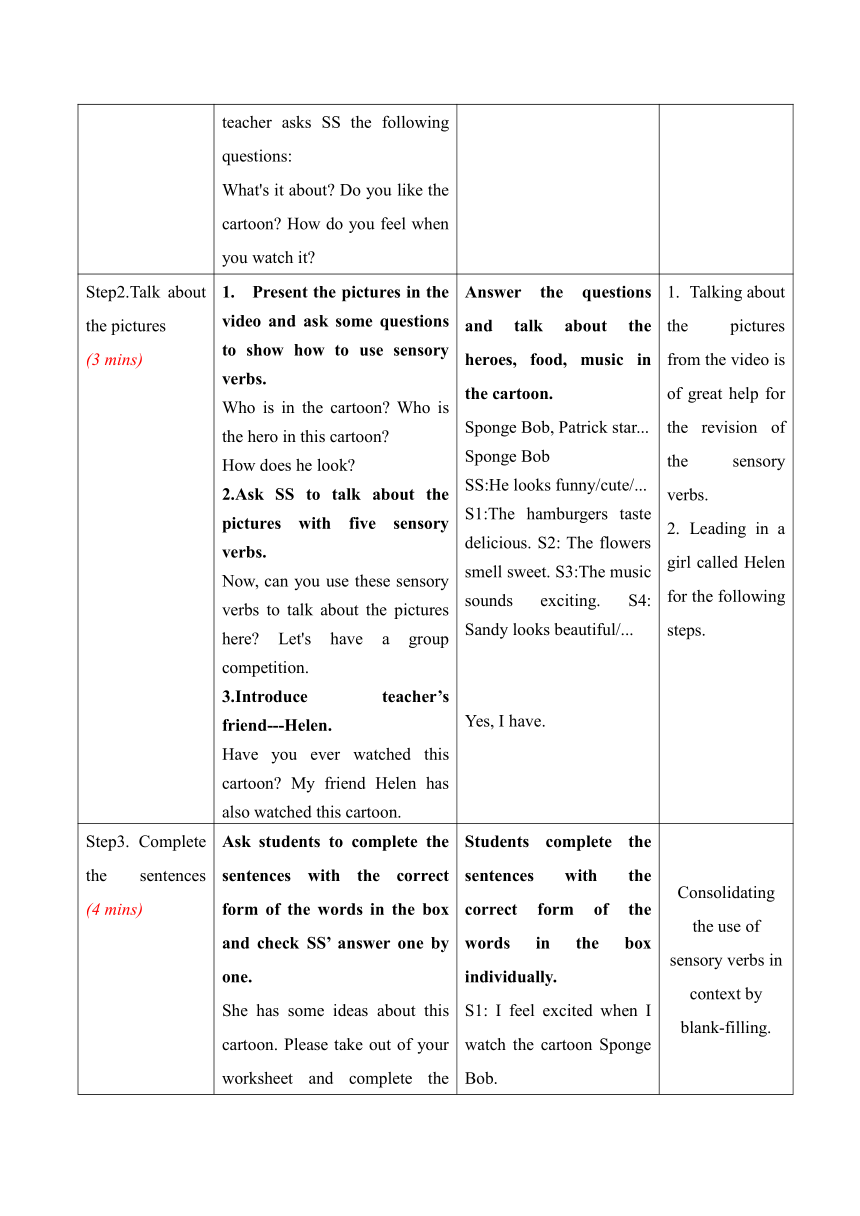
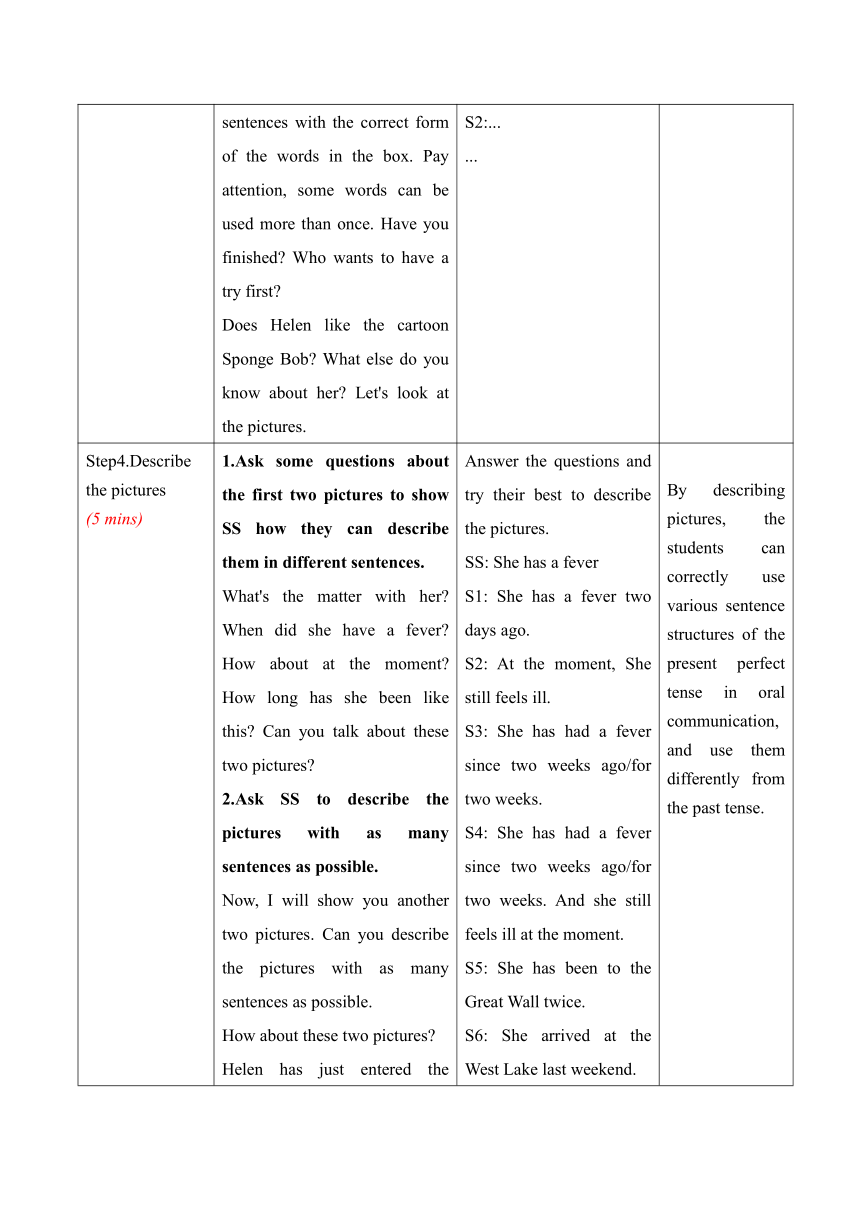
文档简介
Revision Module A
I. Design Ideology
1. This period is designed for students to use sensory verbs and present perfect tense correctly in real-life situations after revising the language items in Module A. The whole lesson is task-based.
2. Revision Module A is designed according to the following principles:
1) Make learning more efficient by sharing, discussing with group mates and competing among groups.
2) Arouse SS’ inspiration to learn English by a clip of a cartoon video, a short poem, blank-filling and real-life communication in class.
3) Find out SS’ shortages in Module A by asking SS to do some tasks before the class. Try to solve the difficulties in class.
II. Analysis of the Teaching Material
The teaching material is from Book 4 of NSE. It plays an important role in Book 4 because of the sensory verbs in Module 1 and present perfect tense from Module 2 to Module 4. Module 5 is an integrated application of simple present tense, simple past tense and present perfect tense.
Because of the limited time and a relatively large number of exercises in Module A, some exercise are used for the assessment of the SS’ learning, others are integrated into the class. The teaching material is close to daily life, so it’s helpful to raise SS’ learning interests and it will also be helpful to improve their writing.
This lesson is a mid-term revision. Students will review what they have learnt in the previous five modules. They will know how to use the sensory verbs and present perfect tense correctly. Meanwhile, they can distinguish the simple past tense from the present perfect tense, use the correct tense to describe the pictures and talk about hobbies and their favorite cartoons.
III. Analysis of the Students
In the previous classes, SS have learned about the sensory verbs, present perfect tense, simple past tense and simple present tense. And they have a great interest in talking about hobbies and cartoons. It won’t be so difficult for them to get involved in the class. SS will be the real masters in class while the teacher will be a guide. Every task is student-oriented.
IV. Objectives
1. Knowledge objectives:
1) Be able to use sensory verbs in the context suitably.
2) Be able to use the present perfect tense correctly and distinguish it from the simple past tense.
3) Be able to talk about one’s hobby and favorite cartoon with simple present tense, simple past tense and present perfect tense.
2. Ability and skill objectives:
1)Be able to improve their listening by circling the key words and listening for key information.
2)Be able to improve their speaking by describing pictures, talking with a partner or in a group.
3)Be able to prepare for their writing by getting the contents from reading and sharing with group mates.
3. Learning strategy:
Be able to learn independently and cooperatively.
4. Affection and Attitude objectives:
1)Be more interested in cartoons and get something from the good cartoons.
2)Learn to appreciate others’ hobbies and favorite cartoon.
5. Cultural objectives:
Learn different culture in different countries by reading or watching cartoons.
V. Keys and Difficulties
Key points:
1)Be able to use sensory verbs in the context suitably.
2)Be able to use the present perfect tense correctly and distinguish it from the simple past tense.
3)Be able to talk about one’s hobby and favorite cartoon with simple present tense, simple past tense and present perfect tense.
Anticipated difficulties:
1)Be able to use the present perfect tense correctly and distinguish it from the simple past tense.
2)Be able to talk about one’s hobby and favorite cartoon with simple present tense, simple past tense and present perfect tense.
VI. Teaching Theories and Strategies
Task-based approach, cooperative learning, independent learning
VII. Pre-class Preparations
1.SS.’ learning preparation:
Finishing the pre-class handout and sharing with the group mates.
2.Teacher’s teaching preparation:
Finding out SS’ problems, adaption of the teaching material and the teaching plan.
3.Teaching aids:
Multimedia teaching equipment, CAI courseware, blackboard, handout
VIII. Teaching Procedure
Teaching Procedure Teacher’s Activities Students’ Activities Purpose of the Design
Step1. Lead-in (3 mins ) 1.GreetingClass begins! Good morning, boys and girls. Sit down please. 2.Invite SS to watch a video and ask some questions about it.Boys and girls, before the class, I'm going yo invite you to watch a short video. Watch very carefully and tell me. What's it about Who is in the video After SS watch the short video, teacher asks SS the following questions:What's it about Do you like the cartoon How do you feel when you watch it Greeting Watch the video and answer the questions.It’s about Sponge Bob. I feel happy/relaxed/... 1.To arouse SS’ interest and attention by watching a lively cartoon video. 2.Questions about the cartoon will be helpful for using the sensory verbs in real-life communication.
Step2.Talk about the pictures (3 mins) Present the pictures in the video and ask some questions to show how to use sensory verbs.Who is in the cartoon Who is the hero in this cartoon How does he look 2.Ask SS to talk about the pictures with five sensory verbs.Now, can you use these sensory verbs to talk about the pictures here Let's have a group competition.3.Introduce teacher’s friend---Helen. Have you ever watched this cartoon My friend Helen has also watched this cartoon. Answer the questions and talk about the heroes, food, music in the cartoon. Sponge Bob, Patrick star...Sponge BobSS:He looks funny/cute/...S1:The hamburgers taste delicious. S2: The flowers smell sweet. S3:The music sounds exciting. S4: Sandy looks beautiful/...Yes, I have. Talking about the pictures from the video is of great help for the revision of the sensory verbs. Leading in a girl called Helen for the following steps.
plete the sentences (4 mins) Ask students to complete the sentences with the correct form of the words in the box and check SS’ answer one by one.She has some ideas about this cartoon. Please take out of your worksheet and complete the sentences with the correct form of the words in the box. Pay attention, some words can be used more than once. Have you finished Who wants to have a try first Does Helen like the cartoon Sponge Bob What else do you know about her Let's look at the pictures. Students complete the sentences with the correct form of the words in the box individually. S1: I feel excited when I watch the cartoon Sponge Bob.S2:...... Consolidating the use of sensory verbs in context by blank-filling.
Step4.Describe the pictures(5 mins) 1.Ask some questions about the first two pictures to show SS how they can describe them in different sentences.What's the matter with her When did she have a fever How about at the moment How long has she been like this Can you talk about these two pictures 2.Ask SS to describe the pictures with as many sentences as possible.Now, I will show you another two pictures. Can you describe the pictures with as many sentences as possible.How about these two pictures Helen has just entered the cartoon competition. She loves drawing cartoons very much. How about her friends Daming and Betty What do they like doing Answer the questions and try their best to describe the pictures.SS: She has a feverS1: She has a fever two days ago.S2: At the moment, She still feels ill. S3: She has had a fever since two weeks ago/for two weeks. S4: She has had a fever since two weeks ago/for two weeks. And she still feels ill at the moment.S5: She has been to the Great Wall twice.S6: She arrived at the West Lake last weekend.S7: ... By describing pictures, the students can correctly use various sentence structures of the present perfect tense in oral communication, and use them differently from the past tense.
Step5.Listen and answer the questions.(3 mins) Ask students to listen and choose the correct answer in the worksheet. Look at the picture, they like keeping the pet dog. Now, let's listen to a conversation between Daming and Betty and learn more about Daming's pet dog. While listening, pay attention to the key information. As for question No.1/..., which one is the key word Now, let’s listen carefully. I think this part is easy for you. Who wants to try the first one Students circle the key words, listen carefully and answer the questions individually.S1: Daming’s aunt gave Daming the dog.S2: ... By listening, we can further consolidate the difference between the present perfect tense and the past tense.
Step6.Pair work (6 mins) Make a model for the students by asking SS hobbies in a train drill. Daming likes taking his dog for a walk in his free time. How about you What do you like doing in your free time How do you feel when you ... When did you start ... How long have you... Have you ever... Ask SS to prepare for the conversation, present in class and ask some questions about it. SS answer the questions individually.SS work in pairs and talk about their hobbies.3.Some SS make presentations in class and others try to answer some questions about it. To use the sensory verbs, the present perfect tense, the present tense and the past tense in meaningful communication.
plete the passage (6 mins) Ask students to complete the passage with the correct form of the words.Different people have different hobbies. Do you still remember her hobby What’s her favorite cartoon Let's read the passage and complete it with the correct form of the words first. Have you finished Who can read the first paragraph/... for us Guide the students to analyze the main points of the article.What's her favorite cartoon It's about “what”. Then ... 1.Students complete the passage with the correct form of the words in the box. 2.Students check their answer by listening to their classmates.S1: I (1)__________ this funny show when I was four years old...Analyze the article and speak out the“wh” words together. SS: what, who, when... 1. By filling in the blanks, we can further consolidate the use of the present tense, the past tense and the present perfect tense in the context.2.By guiding students to analyze the main points of the article, we can lay the groundwork for the following talk show about our favorite cartoon in terms of content and language.
Step8.Talk show (8 mins) 1.Ask students to tell what they can talk about their favorite cartoon and write the key words on the blackboard.What can we talk about our favorite cartoon 2.Ask students to work in groups of four and talk about their favorite cartoon.Please work in groups of four and talk about your favorite cartoon, each student should say at least one sentence. SS answer the questions like: who, when, why...SS works in groups of four and try to show themselves in front of the classroom. By talking about the favorite cartoons in the group, the students can further use the present tense, the present perfect tense and the past tense comprehensively, so that they can use the language in real life.The form of four-person group enables students to help each other, and weak students can also improve their language ability under the leadership of group members.3.The output of spoken English is a good preparation for writing after class.
Step9. A poem(1 min) Ask Students to read and enjoy the little poem. SS read the little poem with the teacher. Appreciate the excellent cartoon works in life, nourish life and live happily.
Step10.Homework(1 min) Level A:Write about your favorite cartoon.Level B:Ask and answer about your partner's favorite cartoon and write about it. The key and difficult points will be consolidated by doing homework.
Blackboard Design G1 G2 G3 G4
教学反思
亮点:
1.主线清晰,遵循任务型教学法,根据本节课的重难点,从词—句—篇章,由易到难,层层铺垫,环环相扣,通过形式多样的活动对语言知识进行操练。
2.注重语言知识在实际交际中的运用,让枯燥的语法知识在课堂中活起来。本节虽然是大模块复习课,但并没有拘泥于习题训练,而是通过听、说、读等形式,让学生活用语言知识,学会用英语做事,让知识来源于生活,回归生活,并为生活服务。
3.内容基于教材,但并不拘泥于教材。由于一节课的时间有限,本人把Revision Module A部分的内容进行了整合与改编以便更好地提高复习的效率。比如:课本1,2,3,4,6的内容改编成了课前导学案,作为学生的评估练习并服务于课堂教学。同时,本人根据学生的课前导学案完成情况发现他们存在的问题并据此进行教学设计。另外,本人把5,7,8,9,10,11,12,13,14的内容进行了合理的改编后运用于课堂教学,培养学生在实际交际中运用语言的能力。
4.个人学习与小组合作学习相结合,以学生为主体,以学定教,充分发挥学生的自主学习和合作学习,关注学生的兴趣和特点,据此设计贴近学生生活的语言活动,比如看卡通视频复习感官动词,灵活运用一般现在时,一般过去时与现在完成时谈论经历,与同伴交流个人爱好,小组讨论最喜爱的卡通片等等,让全体学生都有所学,有所得。
5.在传授知识的同时,注重对学生自主、合作学习策略的指导和渗透。
比如通过课前独立完成导学案,之后与同伴分享交流,互帮互助;课堂上既让学生独立思考,又设计小组活动让所有组员积极参与教学活动。
困惑:
如何使大模块复习课教学更有趣,更高效,形式更多样化?
I. Design Ideology
1. This period is designed for students to use sensory verbs and present perfect tense correctly in real-life situations after revising the language items in Module A. The whole lesson is task-based.
2. Revision Module A is designed according to the following principles:
1) Make learning more efficient by sharing, discussing with group mates and competing among groups.
2) Arouse SS’ inspiration to learn English by a clip of a cartoon video, a short poem, blank-filling and real-life communication in class.
3) Find out SS’ shortages in Module A by asking SS to do some tasks before the class. Try to solve the difficulties in class.
II. Analysis of the Teaching Material
The teaching material is from Book 4 of NSE. It plays an important role in Book 4 because of the sensory verbs in Module 1 and present perfect tense from Module 2 to Module 4. Module 5 is an integrated application of simple present tense, simple past tense and present perfect tense.
Because of the limited time and a relatively large number of exercises in Module A, some exercise are used for the assessment of the SS’ learning, others are integrated into the class. The teaching material is close to daily life, so it’s helpful to raise SS’ learning interests and it will also be helpful to improve their writing.
This lesson is a mid-term revision. Students will review what they have learnt in the previous five modules. They will know how to use the sensory verbs and present perfect tense correctly. Meanwhile, they can distinguish the simple past tense from the present perfect tense, use the correct tense to describe the pictures and talk about hobbies and their favorite cartoons.
III. Analysis of the Students
In the previous classes, SS have learned about the sensory verbs, present perfect tense, simple past tense and simple present tense. And they have a great interest in talking about hobbies and cartoons. It won’t be so difficult for them to get involved in the class. SS will be the real masters in class while the teacher will be a guide. Every task is student-oriented.
IV. Objectives
1. Knowledge objectives:
1) Be able to use sensory verbs in the context suitably.
2) Be able to use the present perfect tense correctly and distinguish it from the simple past tense.
3) Be able to talk about one’s hobby and favorite cartoon with simple present tense, simple past tense and present perfect tense.
2. Ability and skill objectives:
1)Be able to improve their listening by circling the key words and listening for key information.
2)Be able to improve their speaking by describing pictures, talking with a partner or in a group.
3)Be able to prepare for their writing by getting the contents from reading and sharing with group mates.
3. Learning strategy:
Be able to learn independently and cooperatively.
4. Affection and Attitude objectives:
1)Be more interested in cartoons and get something from the good cartoons.
2)Learn to appreciate others’ hobbies and favorite cartoon.
5. Cultural objectives:
Learn different culture in different countries by reading or watching cartoons.
V. Keys and Difficulties
Key points:
1)Be able to use sensory verbs in the context suitably.
2)Be able to use the present perfect tense correctly and distinguish it from the simple past tense.
3)Be able to talk about one’s hobby and favorite cartoon with simple present tense, simple past tense and present perfect tense.
Anticipated difficulties:
1)Be able to use the present perfect tense correctly and distinguish it from the simple past tense.
2)Be able to talk about one’s hobby and favorite cartoon with simple present tense, simple past tense and present perfect tense.
VI. Teaching Theories and Strategies
Task-based approach, cooperative learning, independent learning
VII. Pre-class Preparations
1.SS.’ learning preparation:
Finishing the pre-class handout and sharing with the group mates.
2.Teacher’s teaching preparation:
Finding out SS’ problems, adaption of the teaching material and the teaching plan.
3.Teaching aids:
Multimedia teaching equipment, CAI courseware, blackboard, handout
VIII. Teaching Procedure
Teaching Procedure Teacher’s Activities Students’ Activities Purpose of the Design
Step1. Lead-in (3 mins ) 1.GreetingClass begins! Good morning, boys and girls. Sit down please. 2.Invite SS to watch a video and ask some questions about it.Boys and girls, before the class, I'm going yo invite you to watch a short video. Watch very carefully and tell me. What's it about Who is in the video After SS watch the short video, teacher asks SS the following questions:What's it about Do you like the cartoon How do you feel when you watch it Greeting Watch the video and answer the questions.It’s about Sponge Bob. I feel happy/relaxed/... 1.To arouse SS’ interest and attention by watching a lively cartoon video. 2.Questions about the cartoon will be helpful for using the sensory verbs in real-life communication.
Step2.Talk about the pictures (3 mins) Present the pictures in the video and ask some questions to show how to use sensory verbs.Who is in the cartoon Who is the hero in this cartoon How does he look 2.Ask SS to talk about the pictures with five sensory verbs.Now, can you use these sensory verbs to talk about the pictures here Let's have a group competition.3.Introduce teacher’s friend---Helen. Have you ever watched this cartoon My friend Helen has also watched this cartoon. Answer the questions and talk about the heroes, food, music in the cartoon. Sponge Bob, Patrick star...Sponge BobSS:He looks funny/cute/...S1:The hamburgers taste delicious. S2: The flowers smell sweet. S3:The music sounds exciting. S4: Sandy looks beautiful/...Yes, I have. Talking about the pictures from the video is of great help for the revision of the sensory verbs. Leading in a girl called Helen for the following steps.
plete the sentences (4 mins) Ask students to complete the sentences with the correct form of the words in the box and check SS’ answer one by one.She has some ideas about this cartoon. Please take out of your worksheet and complete the sentences with the correct form of the words in the box. Pay attention, some words can be used more than once. Have you finished Who wants to have a try first Does Helen like the cartoon Sponge Bob What else do you know about her Let's look at the pictures. Students complete the sentences with the correct form of the words in the box individually. S1: I feel excited when I watch the cartoon Sponge Bob.S2:...... Consolidating the use of sensory verbs in context by blank-filling.
Step4.Describe the pictures(5 mins) 1.Ask some questions about the first two pictures to show SS how they can describe them in different sentences.What's the matter with her When did she have a fever How about at the moment How long has she been like this Can you talk about these two pictures 2.Ask SS to describe the pictures with as many sentences as possible.Now, I will show you another two pictures. Can you describe the pictures with as many sentences as possible.How about these two pictures Helen has just entered the cartoon competition. She loves drawing cartoons very much. How about her friends Daming and Betty What do they like doing Answer the questions and try their best to describe the pictures.SS: She has a feverS1: She has a fever two days ago.S2: At the moment, She still feels ill. S3: She has had a fever since two weeks ago/for two weeks. S4: She has had a fever since two weeks ago/for two weeks. And she still feels ill at the moment.S5: She has been to the Great Wall twice.S6: She arrived at the West Lake last weekend.S7: ... By describing pictures, the students can correctly use various sentence structures of the present perfect tense in oral communication, and use them differently from the past tense.
Step5.Listen and answer the questions.(3 mins) Ask students to listen and choose the correct answer in the worksheet. Look at the picture, they like keeping the pet dog. Now, let's listen to a conversation between Daming and Betty and learn more about Daming's pet dog. While listening, pay attention to the key information. As for question No.1/..., which one is the key word Now, let’s listen carefully. I think this part is easy for you. Who wants to try the first one Students circle the key words, listen carefully and answer the questions individually.S1: Daming’s aunt gave Daming the dog.S2: ... By listening, we can further consolidate the difference between the present perfect tense and the past tense.
Step6.Pair work (6 mins) Make a model for the students by asking SS hobbies in a train drill. Daming likes taking his dog for a walk in his free time. How about you What do you like doing in your free time How do you feel when you ... When did you start ... How long have you... Have you ever... Ask SS to prepare for the conversation, present in class and ask some questions about it. SS answer the questions individually.SS work in pairs and talk about their hobbies.3.Some SS make presentations in class and others try to answer some questions about it. To use the sensory verbs, the present perfect tense, the present tense and the past tense in meaningful communication.
plete the passage (6 mins) Ask students to complete the passage with the correct form of the words.Different people have different hobbies. Do you still remember her hobby What’s her favorite cartoon Let's read the passage and complete it with the correct form of the words first. Have you finished Who can read the first paragraph/... for us Guide the students to analyze the main points of the article.What's her favorite cartoon It's about “what”. Then ... 1.Students complete the passage with the correct form of the words in the box. 2.Students check their answer by listening to their classmates.S1: I (1)__________ this funny show when I was four years old...Analyze the article and speak out the“wh” words together. SS: what, who, when... 1. By filling in the blanks, we can further consolidate the use of the present tense, the past tense and the present perfect tense in the context.2.By guiding students to analyze the main points of the article, we can lay the groundwork for the following talk show about our favorite cartoon in terms of content and language.
Step8.Talk show (8 mins) 1.Ask students to tell what they can talk about their favorite cartoon and write the key words on the blackboard.What can we talk about our favorite cartoon 2.Ask students to work in groups of four and talk about their favorite cartoon.Please work in groups of four and talk about your favorite cartoon, each student should say at least one sentence. SS answer the questions like: who, when, why...SS works in groups of four and try to show themselves in front of the classroom. By talking about the favorite cartoons in the group, the students can further use the present tense, the present perfect tense and the past tense comprehensively, so that they can use the language in real life.The form of four-person group enables students to help each other, and weak students can also improve their language ability under the leadership of group members.3.The output of spoken English is a good preparation for writing after class.
Step9. A poem(1 min) Ask Students to read and enjoy the little poem. SS read the little poem with the teacher. Appreciate the excellent cartoon works in life, nourish life and live happily.
Step10.Homework(1 min) Level A:Write about your favorite cartoon.Level B:Ask and answer about your partner's favorite cartoon and write about it. The key and difficult points will be consolidated by doing homework.
Blackboard Design G1 G2 G3 G4
教学反思
亮点:
1.主线清晰,遵循任务型教学法,根据本节课的重难点,从词—句—篇章,由易到难,层层铺垫,环环相扣,通过形式多样的活动对语言知识进行操练。
2.注重语言知识在实际交际中的运用,让枯燥的语法知识在课堂中活起来。本节虽然是大模块复习课,但并没有拘泥于习题训练,而是通过听、说、读等形式,让学生活用语言知识,学会用英语做事,让知识来源于生活,回归生活,并为生活服务。
3.内容基于教材,但并不拘泥于教材。由于一节课的时间有限,本人把Revision Module A部分的内容进行了整合与改编以便更好地提高复习的效率。比如:课本1,2,3,4,6的内容改编成了课前导学案,作为学生的评估练习并服务于课堂教学。同时,本人根据学生的课前导学案完成情况发现他们存在的问题并据此进行教学设计。另外,本人把5,7,8,9,10,11,12,13,14的内容进行了合理的改编后运用于课堂教学,培养学生在实际交际中运用语言的能力。
4.个人学习与小组合作学习相结合,以学生为主体,以学定教,充分发挥学生的自主学习和合作学习,关注学生的兴趣和特点,据此设计贴近学生生活的语言活动,比如看卡通视频复习感官动词,灵活运用一般现在时,一般过去时与现在完成时谈论经历,与同伴交流个人爱好,小组讨论最喜爱的卡通片等等,让全体学生都有所学,有所得。
5.在传授知识的同时,注重对学生自主、合作学习策略的指导和渗透。
比如通过课前独立完成导学案,之后与同伴分享交流,互帮互助;课堂上既让学生独立思考,又设计小组活动让所有组员积极参与教学活动。
困惑:
如何使大模块复习课教学更有趣,更高效,形式更多样化?
同课章节目录
- Module 1 Feelings and impressions
- Unit 1 It smells delicious.
- Unit 2 I feel nervous when I speak Chinese .
- Unit 3 Language in use
- Module 2 Experiences
- Unit 1 I've also entered lots of speaking competi
- Unit 2 They have seen the Pyramids.
- Unit 3 Language in use
- Module 3 Journey to space
- Unit 1 Has it arrived yet?
- Unit 2 We have not found life on any other planet
- Unit 3 Language in use
- Module 4 Seeing the docto
- Unit 1 I haven't done much exercise since I got m
- Unit 2 We have played football for a year now
- Unit 3 Language in use
- Module 5 Cartoons
- Unit 1 It's time to watch a cartoon.
- Unit 2 Tintin has been popular for over eighty yea
- Unit 3 Language in use
- Revision module A
- Module 6 Hobbies
- Unit 1 Do you collect anything ?
- Unit 2 Hobbies can make you grow as a person.
- Unit 3 Language in use
- Module 7 Summer in Los Angeles
- Unit 1 Please write to me and send me some photos
- Unit 2 Fill out a form and come to learn English
- Unit 3 Language in use
- Module 8 Time off
- Unit 1 I can hardly believe we are in the city ce
- Unit 2 We thought somebody was moving about
- Unit 3 Language in use
- Module 9 Friendship
- Unit 1 Could I ask if you've mentioned this to he
- Unit 2 I believe that the world is what you think
- Unit 3 Language in use
- Module 10 On the radio
- Unit 1 I hope that you can join us one day
- Unit 2 It seemed that they were speaking to me in
- Unit 3 Language in use
- Revision module B
